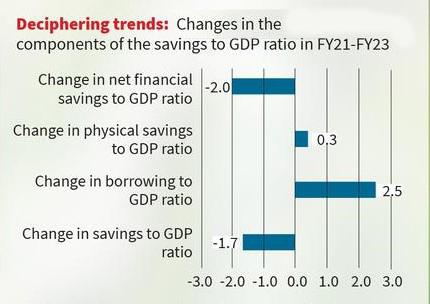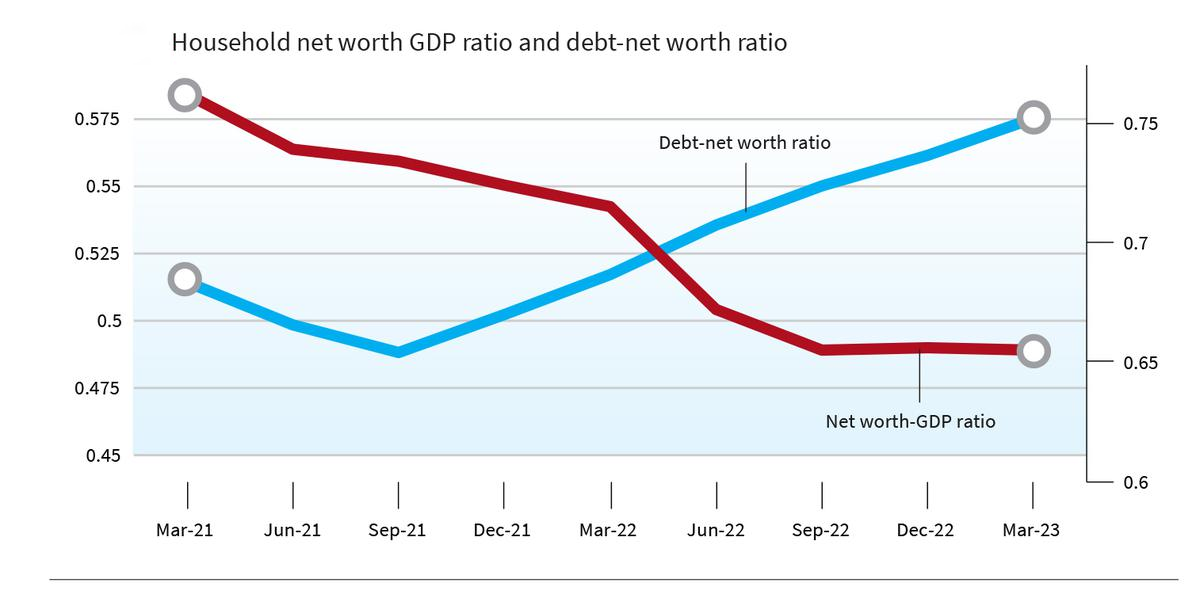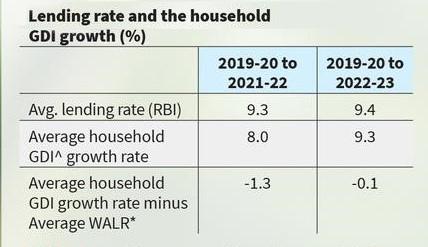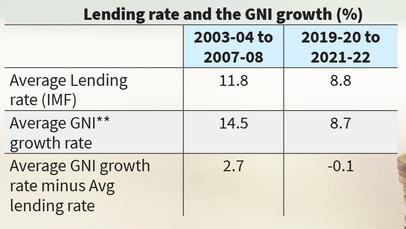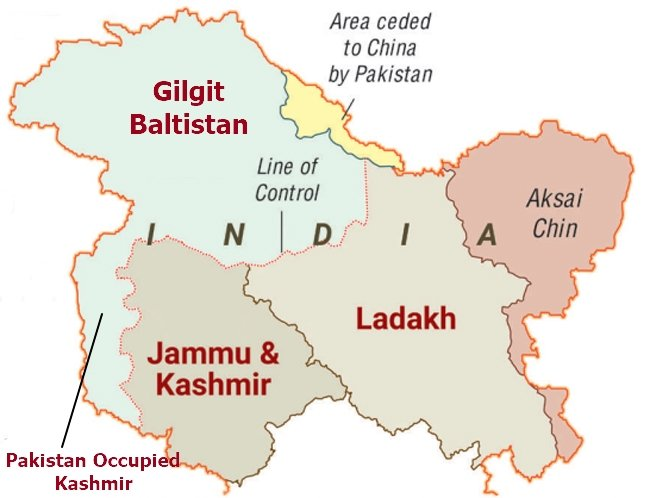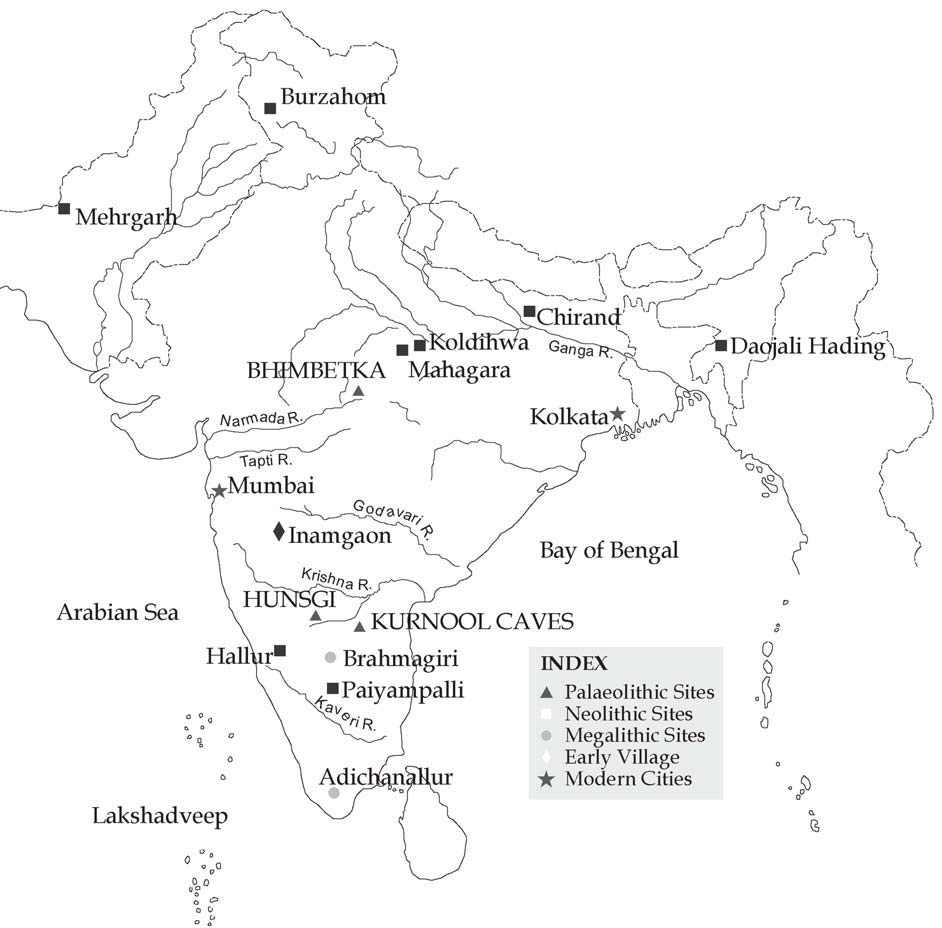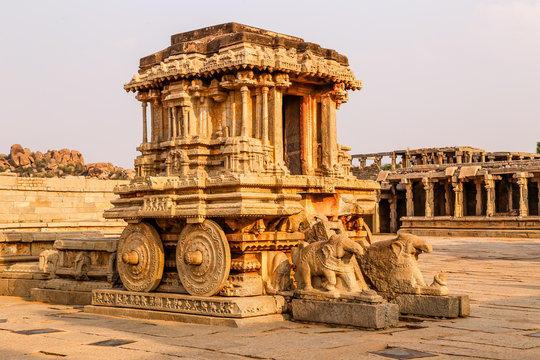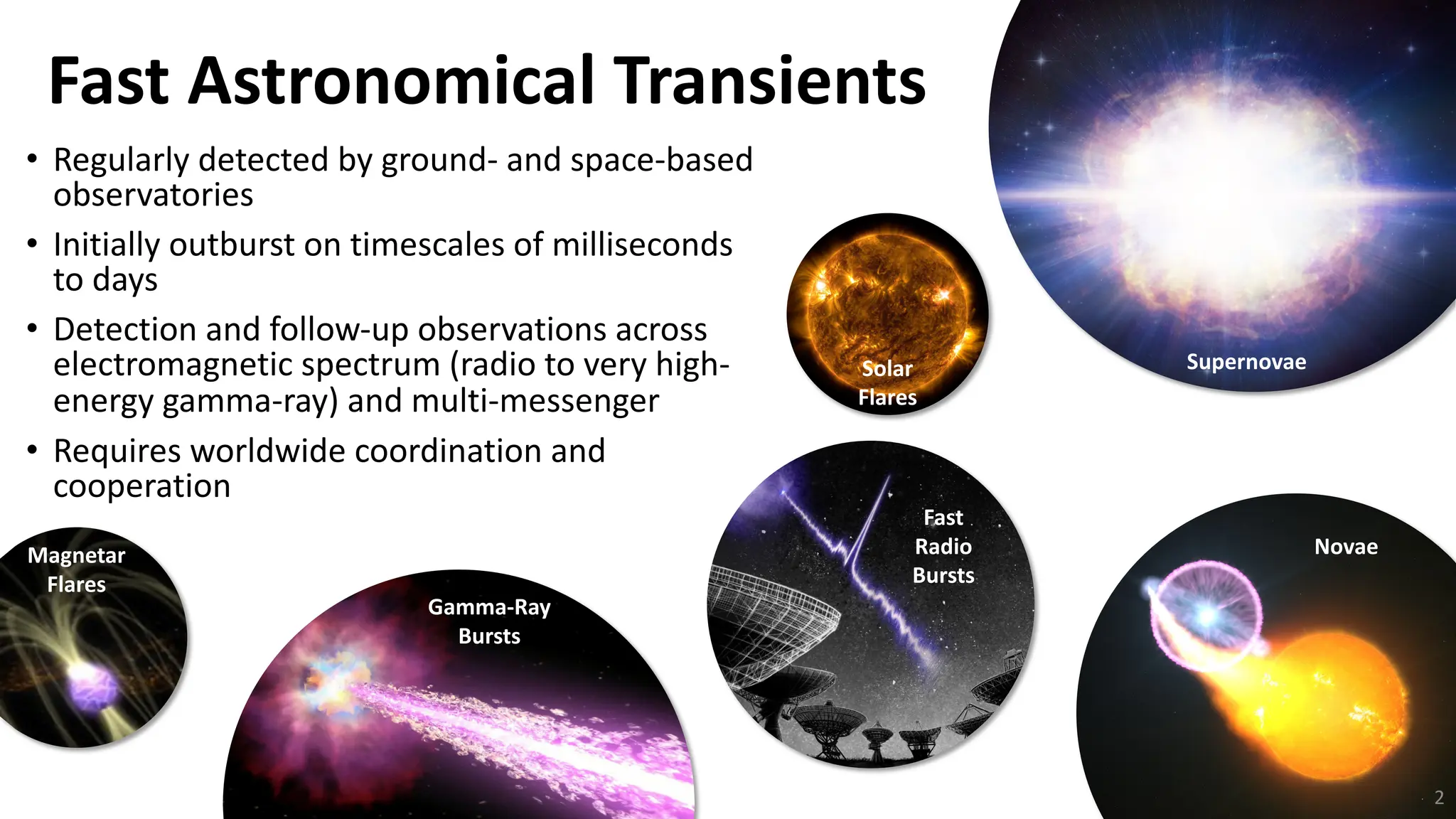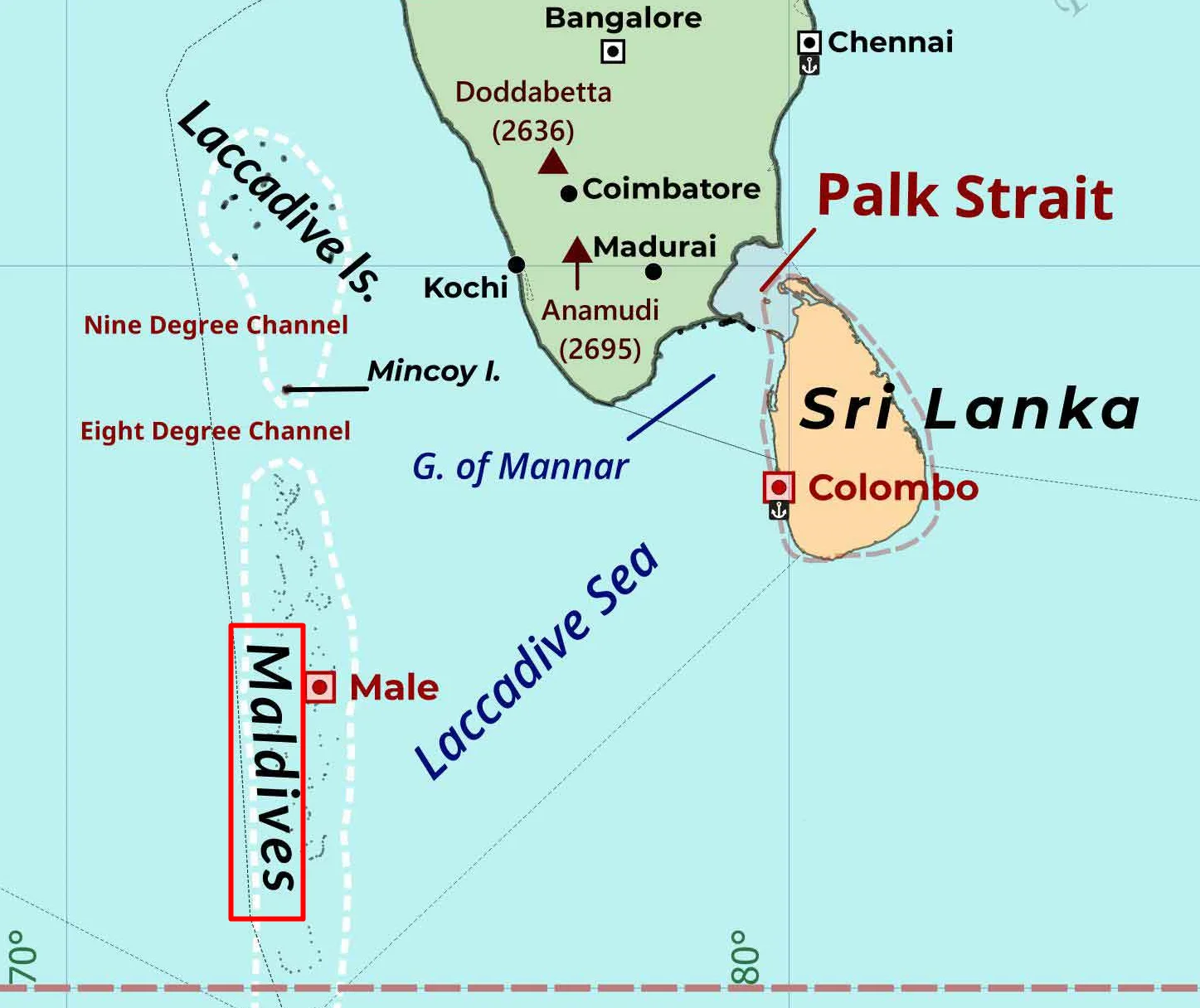Rising Debt Strained Household Savings
For Prelims: Household Consumption Expenditure Survey, National Statistical Office, Gross Domestic Product, Consumer Price Inflation, NITI Aayog, Monthly Per Capita Consumer Expenditure, C. Rangarajan Committee.
For Mains: Highlights of the Recent Household Consumption Expenditure Survey
Why in News?
Recently, there has been debate on the issue of drastic fall in Household Net Financial Savings compared to GDP Ratio during 2022-23 due to higher Borrowing to GDP ratio.
- The Chief Economic Advisor (CEA) to the Government of India interpreted this as a mere shift in the composition of household savings, where households incurred greater borrowing (or reduced net financial savings) solely to finance higher physical savings (investment).
- However, some experts disagree. They think there might be bigger economic reasons behind the trend, not just people's spending habits.
Chief Economic Adviser (CEA) to the Government of India
- He advises the government on economic matters and is responsible for the preparation of the Economic survey of India tabled in Parliament before the Union budget of India is presented.
- CEA is head of Economic Division of the Department of Economic Affairs, Ministry of Finance, Government of India
- He holds the rank of a Secretary to the Government of India.
Note
- Household Net Financial Savings: It refers to the portion of household income that is saved and invested in financial assets, such as bank deposits, stocks, bonds, and other financial instruments, after accounting for financial liabilities like loans and mortgages.
- It represents the net change in financial assets held by households over a period.
- Higher Net financial Savings indicates higher economic stability.
- Household Savings to GDP Ratio: The household savings to GDP ratio is the sum of its net financial savings to GDP ratio, physical savings to GDP ratio and gold and ornaments.
- In mathematical expression form: Household Savings=Net Financial Savings+Physical Savings+ (Gold and Ornaments).
What are the Current Changes in the Saving Pattern?
- Increased Borrowing And Asset Stagnation:
- There has been a greater borrowing (2.5 % points), leading to reduced net financial savings (-2.0% points), but physical savings and investment has not increased much (only 0.3% points).
- This contradicts the government view that greater borrowing (reduced net financial savings) has led to higher physical savings.
- The household savings to GDP ratio declined by 1.7% points while the gold savings to GDP ratio remained largely unchanged.
- There has been a greater borrowing (2.5 % points), leading to reduced net financial savings (-2.0% points), but physical savings and investment has not increased much (only 0.3% points).
- Decline in Household Financial Wealth to GDP Ratio:
- Households are getting poorer relative to the overall economy, while also borrowing more money. This is because the ratio of household financial wealth to GDP has fallen sharply, while the debt-to-net-worth ratio has risen.
- Rise in Interest Payment Burden: Interest payment burden is the product of interest rate and debt-income (DTI) ratio at a given interest rate.
- The debt-to-income (DTI) ratio is a financial metric that compares an individual's monthly debt payments to their gross monthly income.
- A higher debt-to-income ratio indicates that a person may be at risk of defaulting on their loans, while a lower ratio demonstrates that they have more disposable income to cover their debt obligations.
- The recent period has been associated with a sharp rise in both these variables (DTI and interest payment).
- The debt-income ratio of households can change due to two factors.
- Higher net borrowing-income ratio, where net borrowing is the difference between total borrowing and interest payments.
- Household’s stock of debt would rise at any given level of income if they decide to increase their net borrowing for financing higher investment or consumption.
- Increase in interest rates or reduction in nominal income growth rate.
- If the growth in interest payments outweighs income growth, the debt-income ratio will continue to grow. Such mechanisms can be described as “Fisher dynamics” (phenomenon of rising debt-income ratio in terms of changes in interest rate and nominal income growth rate).
- Higher net borrowing-income ratio, where net borrowing is the difference between total borrowing and interest payments.
- The debt-to-income (DTI) ratio is a financial metric that compares an individual's monthly debt payments to their gross monthly income.
- Household Income Growth Lags Behind Lending Rate:
- For the period 2019-20 to 2022-23, the average value of the growth rate of household disposable income (8% in 2019-20 to 2021-22 and 9.3% in 2019-20 to 2022-23) has been lower than the weighted average lending rate (WALR) (9.3% in 2019-22 and 9.4% in 2019-23).
- The average value of the lending rate for this period is constructed from the Reserve Bank of India’s quarterly figures.
- For the period 2019-20 to 2022-23, the average value of the growth rate of household disposable income (8% in 2019-20 to 2021-22 and 9.3% in 2019-20 to 2022-23) has been lower than the weighted average lending rate (WALR) (9.3% in 2019-22 and 9.4% in 2019-23).
- Decline in Savings and Investment Between 2003-08 and 2019-22:
- From 2003-04 to 2007-08, Average Gross National Income (GNI) growth rate (14.5%) was greater than the average lending rate (11.5%).
- This implied that incomes were growing faster than the cost of borrowing.
- From 2003-04 to 2007-08, Average Gross National Income (GNI) growth rate (14.5%) was greater than the average lending rate (11.5%).
- Fisher Dynamics at Play Since 2019-20:
- It is the phenomenon of rising debt-income ratio due to changes in interest rate and nominal income.
- Since the economic slowdown in 2019-20, the Indian economy has shown signs of Fisher dynamics.
- After, Covid-19 there has been a sharp increase in the amount of debt compared to income for households, mainly due to lower nominal income growth rate.
- With the emergence of the Fisher dynamics, there are 2 unique challenges that confront the Indian economy.
- Increasing Income-Debt Gap: It can lead to higher interest payments for households.
- Reduced Consumption: Higher debt prompts households to cut back on spending. The consumption to GDP ratio dropped in 2023-24, showing this trend.
What are the Macroeconomic Implications of Rising Household Debt Burden?
- Debt repayment: It can become difficult if interest rates rise faster than income growth. This can strain the financial sector as they receive less interest income from households struggling to repay debt. This in turn can lead to reduced credit availability for businesses.
- Consumption Demand: It can also be reduced by high household debt. If households feel financially insecure, they may save more and spend less, slowing down the overall economy.
- Higher Interest Rates to Fight Inflation: If interest rates are raised to combat inflation, this can worsen household debt burdens and push them into a debt trap. This is because higher interest rates will increase the amount of money that households have to pay on their debts.
- Financialisation of the economy: The shift towards financial assets in household balance sheets suggests that the economy is becoming more financialised. This means that a larger share of economic activity is focused on financial markets rather than on the production of goods and services. This can make the economy more fragile and prone to financial crises.
- Financialisation refers to a trend in economies where financial markets take precedence over production, with individuals turning to financial assets like stocks and bonds to accumulate wealth.
Way Forward
- Focus on Income Growth and Debt Control: The gap between interest rates and income growth needs to decrease, and the growth of household debt compared to income needs to slow down.
- Boosting Income Growth: Policies and initiatives that promote job creation, wage increases, and overall economic growth are crucial.
- Managing Debt Levels: Encouraging responsible borrowing practices and potentially regulating excessively high lending rates can help households manage debt more effectively.
- Wage Growth: If wages increase at a pace that outpaces interest rates, households will have more disposable income to manage debt and potentially spend more.
- Debt Management Strategies: Financial education initiatives and responsible lending practices can help households manage debt more effectively, freeing up some income for spending.
|
Drishti Mains Question: Discuss India's decline in household financial wealth and rising borrowing costs. Analyse the potential macroeconomic challenges stemming from this trend and propose policy measures to address them. |
UPSC Civil Services Examination, Previous Year Question:
Q. As per the NSSO 70th Round “Situation Assessment Survey of Agricultural Households”, consider the following statements: (2018)
- Rajasthan has the highest percentage share of agricultural households among its rural households.
- Out of the total agricultural households in the country, a little over 60 percent belong to OBCs.
- In Kerala, a little over 60 percent of agricultural households reported to have received maximum income from sources other than agricultural activities.
Which of the statements given above is/are correct?
(a) 2 and 3 only
(b) 2 only
(c) 1 and 3 only
(d) 1, 2 and 3
Ans: c
2. In a given year in India, official poverty lines are higher in some States than in others because (2019)
(a) poverty rates vary from State to State
(b) price levels vary from State to State
(c) Gross State Product varies from State to State
(d) quality of public distribution varies from State to State
Ans: (b)
Political and Economic Reforms in 1991
For Prelims: T. N. Seshan Electoral Reforms, Model Code of Conduct, Electors Photo Identity Card, Election Commission, Liberation Tigers of Tamil Eelam (LTTE),
For Mains: T. N. Seshan Electoral Reforms, Liberalization, Privatization, and Globalization (LPG) reforms
Why in News?
As India gears up for the 2024 general election, it is important to reflect on the pivotal 1991 Indian general elections, which marked a significant turning point in the country's history.
- These elections led to profound political and economic changes, driven by the leadership of PV Narasimha Rao and the impactful electoral reforms spearheaded by T N Seshan.
What were the Key Electoral Reforms Introduced by T. N. Seshan?
- Tirunellai Narayana Iyer Seshan (T N Seshan) was appointed the Chief Election Commissioner (CEC) from 1990 to 1996 and spearheaded a series of groundbreaking reforms that significantly transformed the Indian electoral process.
- Key Reforms:
- Voter ID cards: Widely known as EPIC (Electors Photo Identity Card), this was introduced in his tenure to prevent impersonation and bogus voting.
- Strict enforcement of MCC: The Model Code of Conduct (MCC), existing since 1960, outlines guidelines for political parties during elections. Seshan rigorously enforced it, curbing misuse of power and unfair advantages.
- Curbing electoral malpractices: The Election Commission under Seshan's leadership listed 150 malpractices.
- He cracked down on vote buying, bribing, intimidation of voters, booth capturing, and the use of muscle power.
- He also banned excessive spending and public displays during campaigns.
- Independent and impartial elections: Seshan ensured deployment of central police forces to maintain order and prevent violence. He also advocated for autonomous status for the Election Commission.
- Seshan’s Reforms Impact on the 1991 Elections:
- The 1991 elections were conducted with unprecedented integrity and transparency, setting new standards for future elections.
- Despite the prevailing political instability, a turnout of 56.73% was recorded. This was lower than the 61.95% in 1989 but reflected a more genuine participation compared to previous elections marred by irregularities.
- Long-term Impacts:
- Transformed the Election Commission from a passive observer to an active enforcer of electoral laws.
- Strengthened the autonomy and integrity of the Election Commission, ensuring free and fair elections.
- Recognition:
- Seshan’s efforts in electoral reforms earned him the prestigious Ramon Magsaysay Award in 1996, highlighting his impact on global standards of electoral integrity.
What was the Political Context of the 1991 Elections?
- In May 1991, Rajiv Gandhi was assassinated by a suicide bomber from the Liberation Tigers of Tamil Eelam (LTTE) leading to a politically charged and fractured environment during the elections.
- Following Rajiv Gandhi's death, PV Narasimha Rao was sworn in as Prime Minister on 21st June 1991.
How did Economic Reforms Unfold Under Rao’s Government?
- Economic Crisis: India was on the verge of a sovereign default due to depleted foreign exchange reserves, exacerbated by the Gulf War (1991) which led to increased oil prices and reduced remittances from overseas workers.
- The fiscal deficit soared to 8% of GDP, and the current account deficit was 2.5% of GDP. Inflation rates were in double digits, further burdening the population.
- Forex reserves plummeted to less than USD 6 billion, barely enough to cover two weeks' worth of imports.
- Immediate Measures to Mitigate the Crisis:
- Rupee Devaluation: On 1st July 1991, the rupee was devalued by 9% against major currencies, followed by an additional 11% devaluation two days later. This was aimed at making Indian exports more competitive.
- Rao chose a phased devaluation to manage the political and economic shock.
- Pledging Gold Holdings: The Reserve Bank of India (RBI) pledged gold with the Bank of England in July 1991, raising around USD 400 million.
- In May 1991, during national elections, 20 tonnes of gold were sold to the Union Bank of Switzerland, raising approximately USD 200 million.
- Earlier in the year, the government secured about USD 2 billion in emergency loans from the International Monetary Fund (IMF).
- Rupee Devaluation: On 1st July 1991, the rupee was devalued by 9% against major currencies, followed by an additional 11% devaluation two days later. This was aimed at making Indian exports more competitive.
- LPG Reforms:
- PM Rao along with Finance Minister Manmohan Singh, initiated the LPG reforms (Liberalization, Privatization, and Globalization) that were introduced as a cornerstone of India's economic strategy to overcome the crisis and promote sustainable growth.
- Liberalisation:
- New Trade Policy: Introduced to boost exports by revamping the licensing process and linking non-essential imports to exports.
- Exim Scrips: The government removed export subsidies and instead introduced tradeable exim scrips for exporters based on the value of exports.
- The policy ended the monopoly of state-owned firms over imports, enabling the private sector to import goods independently.
- Ending Licence Raj: The new industrial policy dismantled the licence raj, relaxing Monopolies and Restrictive Trade Practices Act provisions to facilitate business restructuring and mergers.
- The policy abolished industrial licensing for all but 18 industries, irrespective of investment levels.
- Privatisation:
- FDI Reforms: Automatic approval for foreign direct investment (FDI) up to 51% was introduced, compared to the previous cap of 40%.
- Public Sector Monopoly Restriction: Restricted public sector monopoly to sectors critical for national security.
- Opening Markets: These changes made it easier to do business in India, attracting a deluge of foreign goods and investments in subsequent years.
- Globalisation:
- Economic Policies: The reforms aimed at integrating India’s economy with the global market, encouraging international trade and investment.
- Boosting Exports: With the massive devaluation of the rupee and new trade policies, Indian exports became more competitive globally.
- Impact of LPG Reforms:
- The LPG reforms in India led to high economic growth, with GDP increasing from USD 270 billion in 1991 to USD 2.9 trillion in 2020.
- FDI inflows also increased significantly, reaching USD 82 billion in 2020-21 from USD 97 million in 1991.
- The reforms dismantled the License Raj, promoting industrial growth in sectors such as IT, telecom, and automobiles.
- While the reforms created jobs and reduced poverty, there are still concerns about job quality and income inequality.
- The reforms also integrated the Indian economy into the global economy, increasing trade and investment flows, with India's share in global trade rising from 0.5% in 1991 to around 2% in 2022.
- The LPG reforms in India led to high economic growth, with GDP increasing from USD 270 billion in 1991 to USD 2.9 trillion in 2020.
|
Drishti Mains Question: Q. Evaluate the significance of the Model Code of Conduct in ensuring free and fair elections. How did strict enforcement of the MCC contribute to electoral reforms? Q. Assess the economic crisis faced by India in 1991 and the immediate measures taken by the government to mitigate the crisis. How did these measures impact India's economy? |
UPSC Civil Services Examination, Previous Year Questions (PYQs)
Prelims
Q. Which of the following has/have occurred in India after its liberalization of economic policies in 1991? (2017)
- Share of agriculture in GDP increased enormously.
- Share of India’s exports in world trade increased.
- FDI inflows increased.
- India’s foreign exchange reserves increased enormously.
Select the correct answer using the codes given below:
(a) 1 and 4 only
(b) 2, 3 and 4 only
(c) 2 and 3 only
(d) 1, 2, 3 and 4
Ans: (b)
Q. With reference to the Indian economy after the 1991 economic liberalization, consider the following statements:
- Worker productivity (Rs. per worker at 2004-05 prices) increased in urban areas while it decreased in rural areas.
- The percentage share of rural areas in the workforce steadily increased.
- In rural areas, the growth in non-farm economy increased.
- The growth rate in rural employment decreased.
Which of the statements given above is/are correct?
(a) 1 and 2 only
(b) 3 and 4 only
(c) 3 only
(d) 1, 2 and 4 only
Ans: (b)
Socio-Economic Factors Fueling Unrest in PoK
For Prelims: Pakistan-occupied Kashmir, Most Favored Nation (MFN) status, Pulwama attack, Line of Control (LoC), Article 370, Indo-Pacific
For Mains: Impact of trade disruptions between India and Pakistan, Pakistan Occupied Kashmir (PoK), Instability in Pakistan, Opportunities and threats for India
Why in News?
Protests have intensified in Pakistan-occupied Kashmir (PoK) due to soaring prices and economic woes. The region’s unrest has led to violent clashes, causing deaths. Pakistan’s economic crisis, marked by high inflation, has worsened living conditions.
- Trade in PoK suffered after India hiked customs duties on Pakistani goods post the 2019 Pulwama attack, exacerbating the financial strain.
Why is Pakistan's Economy Struggling?
- High Inflation: Consumer inflation has been above 20% since May 2022, reaching 38% in May 2023.
- Energy Costs: The cost of energy in Pakistan has risen significantly, contributing to the overall inflation. This has a cascading effect on the prices of goods and services across the economy.
- Trade Disruptions: After the Pulwama attack in 2019, India accused Pakistan and revoked its Most Favored Nation (MFN) status, imposing a 200% import duty on Pakistani products such as dry dates, rock salt, cement, and gypsum.
- Following Pulwama, India also accused Pakistan of cross-border terrorism, smuggling, and money laundering, leading to the suspension of trade across the Line of Control (LoC).
- This led to a sharp decline in Pakistan's exports to India, from an average of USD 45 million per month in 2018 to only USD 2.5 million per month between March and July 2019.
- The significant reduction in exports to India has severely impacted traders, particularly in regions like PoK, contributing to economic instability.
- The revocation of Article 370 by India further complicated the situation, as Pakistan sees it as an attack on the disputed territory.
- High tariffs imposed by India act as a significant barrier to resuming normal trade activities.
- In 2021, Pakistan attempted to normalise trade relations with India, but domestic pressures and the Kashmir issue halted progress.
- The current status of trade ties between India and Pakistan remains suspended from 2019.
Why doesn't India Want to Resume Trade Relations with Pakistan?
- India's trade with Pakistan has always been a minor part of its overall foreign trade, accounting for less than 1% of its exports and imports.
- Political instability, fewer foreign reserves, strict visa policies, and Pakistan's small market size compared to India's make trade with Pakistan a risky proposition for India.
- Some in India believe that the minimal threat from Pakistan's military, which is preoccupied with its western borders, reduces the need for confidence-building measures through trade.
India-Pakistan Trade Before Ban
- Since 1996, Pakistan has had MFN status but maintained a Negative List of 1,209 products not allowed to be imported from India.
- Only 138 products were allowed through the Wagah-Attari border.
- Despite this, India had a significant trade surplus over Pakistan, exporting more goods and services to Pakistan than it imported from Pakistan.
- Political tensions between India and Pakistan significantly affected trade volume, often resulting in trade restrictions and reduced activity.
- Indian Export to Pakistan: In 2018-19, half of Indian exports to Pakistan were cotton and organic chemicals. Other significant items included plastic, tanning/dyeing extracts, nuclear reactors, boilers, machinery, and mechanical appliances.
- Indian Import From Pakistan: In 2018-19, India imported mineral fuels and oils, edible fruits and nuts, salt, sulphur, stone, slag, and ash, and leather from Pakistan.
- After the ban, many imports decreased significantly. The only increase has been in pharmaceutical products, as Pakistan imported drug products and organic chemicals to ensure an adequate supply of medicines during the Covid-19 pandemic.
What are the Prospects for Future India-Pakistan Trade Negotiations?
- Historically, successful India-Pakistan negotiations have occurred in private settings, and the post 2024 Indian general election environment in both countries may provide an opportunity for quiet diplomacy.
- The sustained ceasefire along the LoC and the absence of spectacular acts of terrorism since Pulwama provide a favourable premise for restarting India-Pakistan relations.
- Business-to-business links and the potential for Pakistan to facilitate Indian trade to Afghanistan and Central Asia through its territory could be leveraged to advocate for bilateral trade.
- Improved India-Pakistan trade relations could also boost India's regional influence, which has been declining due to China's growing influence and India's focus on the Indo-Pacific.
What is Pakistan Occupied Kashmir (PoK)?
- Historical Context: PoK was historically part of the princely state of Jammu and Kashmir, which acceded to India in 1947 after the Partition.
- However, the region was illegally occupied by Pakistan in 1947 following an invasion by Pashtun tribesmen and the Pakistani Army.
- Geographical Extent: PoK covers an area of 13,297 sq km and has a population of over 40 lakh people. It is divided into 10 districts, with the capital being Muzaffarabad.
- In 1963, Pakistan ceded over 5,000 sq km of this land to China in the Shaksgam area.
- Gilgit Baltistan:
- Gilgit Baltistan (GB) is a separate region to the north of PoK and east of the Pakistani province of Khyber Pakhtunkhwa.
- GB was leased to the Dogra ruler of Jammu by the British and later handed over to Pakistan in 1947.
- Gilgit Baltistan (GB) is a separate region to the north of PoK and east of the Pakistani province of Khyber Pakhtunkhwa.
- Administrative Status: Neither PoK nor GB are officially listed as part of Pakistan's four provinces.
- Both are considered "autonomous territories" ruled directly from Islamabad, a fiction maintained by Pakistan to avoid damaging its international position on the Kashmir dispute.
- India's Position: For India, PoK and GB are part of the state of Jammu and Kashmir, which is an integral part of the country as per the 1994 Parliamentary resolution.
|
Drishti Mains Question: Q. What are the effects of trade suspension on border communities between India and Pakistan. Discuss the potential benefits of normalising trade ties and the challenges involved. |
UPSC Civil Services Examination, Previous Year Question (PYQ)
Prelims
Q. Siachen Glacier is situated to the (2020)
(a) East of Aksai Chin
(b) East of Leh
(c) North of Gilgit
(d) North of Nubra Valley
Ans: (d)
- The Siachen Glacier is located in the Eastern Karakoram range in the Himalayas, just northeast of Point NJ9842 where the Line of Control between India and Pakistan ends.
- It has the distinction of being the largest glacier outside the polar and subpolar regions.
- It lies to the west of Aksai Chin, north of Nubra valley and almost east of Gilgit
Mains
Q. "Increasing cross border terrorist attacks in India and growing interference in the internal affairs of several member states by Pakistan are not conducive for the future of SAARC (South Asian Association for Regional Cooperation)." Explain with suitable examples. (2016)
Q. Terrorist activities and mutual distrust have clouded India – Pakistan relations. To what extent the use of soft power like sports and cultural exchanges could help generate goodwill between the two countries? Discuss with suitable examples. (2015)
Wooden Artifacts of Stone Age
Why in News?
Recently, research has challenged the traditional view of the Stone Age, suggesting it might be more aptly described as the 'Wood Age'.
- This perspective arises from the discovery and analysis of wooden artifacts dating back 300,000 to 400,000 years in Schöningen, Germany.
- Recently, the discovery of prehistoric artifacts at Ghugwa, Madhya Pradesh suggests that ancient hunter-gatherers utilised fossil wood to fashion tools, estimated to be over 10,000 years old, comprising mid-sized flakes and microliths found in the same area.
Note
Human presence in India and Germany stretches back millennia, with stone tools dating to 1.5 million years in the Narmada Valley and 800,000 years in the Rhine Valley, respectively.
How Wooden Tools Challenge Ideas of the Stone Age?
- Sophisticated Wooden Tools: The artifacts exhibited a diverse range of woodworking techniques beyond simple sharpened sticks.
- Insights into Early Human Behaviour and Capabilities: The unearthing of ancient hunting tools challenges the perception of prehistoric humans as mere scavengers, revealing their strategic hunting, planning skills, and technological adaptability through tool repair and reuse.
- Preservation Bias: Research highlights a bias in archaeology towards preserving stone over organic materials, which may distort our understanding of wood's importance in prehistoric times, despite well-preserved wooden artifacts revealing its crucial role.
What is the Stone Age?
- The Stone Age began when hominids first picked up stone tools, some 3.4 million years ago (mya), in modern-day Ethiopia. This period, which went on till about 6,000-4,000 BP (Before Present), comprises 99% of human history.
- Stone Age in India: India's varied land, water, plants, and animals helped people live all over except in the Himalayas and the Indo-Gangetic plains during the Stone Age. The Stone Age is divided into three main periods namely the Paleolithic, the Mesolithic, and the Neolithic. Further, the Indian Palaeolithic is divided into three developmental stages:
- Lower Palaeolithic (600,000 years BP to 150,000 years BP): It involved the use of large pebbles or flakes for making choppers and chopping tools, hand axes, cleavers, knives etc. The Lower Palaeolithic has two cultural traditions:
- Soanian pebble-tool tradition
- The Peninsular Indian handaxe-cleaver tradition.
- Middle Palaeolithic (165,000 BP to 31,000 years BP): It is based on the use of a variety of flakes struck from cores for preparing scrapers, points, borers and other tools.
- Upper Palaeolithic (40,000 years BP to 12,000 years BP): In this phase, improvements included making various types of tools like blunted blades, penknife blades, blades with serrated edges, and arrow points from long parallel-sided blades using a punch technique.
- Lower Palaeolithic (600,000 years BP to 150,000 years BP): It involved the use of large pebbles or flakes for making choppers and chopping tools, hand axes, cleavers, knives etc. The Lower Palaeolithic has two cultural traditions:
- Mesolithic Culture: During this era, people inhabited semi-permanent and temporary settlements, utilised caves and open areas, practised burial rituals, demonstrated artistic abilities, maintained cultural continuity, and utilised microlithic tools for hunting smaller prey.
- Neolithic period: It marked the beginning of agriculture and animal domestication.
- Early evidence of Neolithic culture is found in the Fertile Crescent region of Egypt and Mesopotamia, the Indus region, the Ganges Valley of India, and also in China.
UPSC Civil Services Examination, Previous Year Question (PYQ)
Prelims:
Q. Consider the following pairs: (2021)
(Historical Place) (Well-known for)
- Burzahom : Rock-cut shrines
- Chandraketugarh : Terracotta art
- Ganeshwar : Copper artefacts
Which of the pairs given above is/are correctly matched?
(a) 1 only
(b) 1 and 2
(c) 3 only
(d) 2 and 3
Ans: (d)
Q. Which one of the following is not a Harappan site? (2019)
(a) Chanhudaro
(b) Kot Diji
(c) Sohgaura
(d) Desalpur
Ans: (c)
Restoration of Virupaksha Temple Pavilion
Why in News?
The Archaeological Survey of India (ASI) is set to begin restoration work on the collapsed saalu mantapa or pavilion (a type of Mandapa) at the iconic Virupaksha temple aPrauda Deva Raya part of the Group of Monuments at Hampi, designated as a UNESCO World Heritage Site.
What are the Key Facts About Virupaksha Temple Hampi?
- Virupaksha Temple is the 7th-century Shiva temple in Hampi, Central Karnataka.
- Lord Virupaksha, also referred to as Pampapathi is the main deity in Virupaksha Temple.
- The Virupaksha Temple was built in the Vijayanagara style of architecture and was built by Lakkan Dandesha, a nayaka under the ruler Deva Raya II, also known as of the Vijayanagara Empire.
Group of Monuments at Hampi
- Hampi, located in central Karnataka on the banks of the Tungabhadra River, is a UNESCO World Heritage Site. Spread over an area of nearly 4,200 hectares, the site contains over 1,600 surviving monuments, including forts, temples, palaces, and other structures.
- It was once the capital of the Vijayanagara Empire, known for its historical and archaeological significance.
- The location of Hampi, amid craggy hills and the Tungabhadra River, provided a natural defensive setting for the capital city.
- Hampi's monuments showcase the pinnacle of Vijayanagara architecture, a synthesis of the Dravidian style with Indo-Islamic influences.
- Architectural Marvels: The Vitthala Temple complex, features exquisitely carved pillars and the iconic Stone Chariot.
- The Royal Enclosure with its majestic structures like the Lotus Mahal and Elephant Stables.
- The Hazara Rama Temple, is known for its intricate stone carvings and sculpted panels.
- The massive Virupaksha Temple, one of the oldest and most sacred sites in Hampi.
- Notable Structures: Krishna temple complex, Narasimha, Ganesa, Hemakuta group of temples, Achyutaraya temple complex, Vitthala temple complex, Pattabhirama temple complex, and Lotus Mahal complex.
- The ruins at Hampi were brought to light in 1800 by an engineer and antiquarian named Colonel Colin Mackenzie.
- In recognition of its outstanding universal value, the United Nations Educational, Scientific and Cultural Organization (UNESCO) inscribed Hampi as a World Heritage Site in 1986.
Extending Tenure of Current Army Chief
The Appointments Committee of Cabinet (ACC), headed by the Prime Minister, has granted a rare one-month extension in service to the current Chief of the Army Staff (COAS), General Manoj Pande.
- This is only the second such extension granted in over five decades, the first being to General GG Bewoor, who succeeded Field Marshal SHFJ Manekshaw as army chief in 1973.
- The ACC approved the extension of current COAS service for one month beyond his normal under Rule 16 A (4) of the Army Rules 1954 which deals with retaining officers on the grounds of “exigencies of services”, with the final decision resting with the Central Government.
- The COAS is the highest-ranking officer in the Indian Army, appointed by the ACC.
- The COAS serves as the head of the army and advises the Defence Ministry on army-related matters and also serves as the key military advisor to the President of India.
- The COAS retires after three years of appointment or at the age of 62, whichever comes first.
Read more: Advancing Defense Integration in India
Astronomical Transients
Recently, an Indian-American astronomer Shrinivas Kulkarni was awarded the Shaw Prize for Astronomy in 2024 for his work on the physics of astronomical transients.
- Astronomical transients are celestial objects or phenomena that change their brightness over a relatively short period of time, as compared to longer periods of time over which stars and galaxies change and develop.
- Studying these energetic, short-lived cosmic events could unlock secrets of the universe's most powerful objects and physical laws. Some of the different types of astronomical transients are:
- Supernovae: When the cores of massive stars collapse due to the depletion of fusionable elements, their outer layers explode, releasing immense energy and briefly outshining their entire host galaxy.
- Active galactic nucleus (AGN): Supermassive black holes at the cores of massive galaxies sometimes actively consume surrounding matter. This interaction causes the matter to emit light with varying brightness.
- Fast radio bursts (FRBs): FRBs are powerful bursts of radio waves that can release as much energy in a few thousandths of a second as the sun emits in three days.
Read more: Astronomical Grand Cycles, String of Pearls Supernova
Launch of RuPay Services in Maldives
Maldives will soon launch India's RuPay service in its country.
- RuPay is the first-of-its-kind domestic Card payment network of India, with wide acceptance at ATMs, Point of Sale (POS) devices and e-commerce websites across India.
- RuPay is a product of National Payment Corporation of India (NPCI), the umbrella organization that powers retail payments in the country.
- NPCI is a "Not for Profit Company" under the Companies Act.
- The Payment and Settlement Systems Act, 2007, gave authority to the Reserve Bank of India (RBI) and Indian Banks’ Association (IBA) to establish a safe electronic payment and settlement system in India.
- NPCI International Payments Ltd (NIPL) is the international arm of (NPCI), established in 2018 to export India's digital payment solutions like RuPay and UPI globally.
- RuPay has launched various card variants catering to the different segments of society.
- RuPay is a product of National Payment Corporation of India (NPCI), the umbrella organization that powers retail payments in the country.
- RuPay's transactions are already accepted in Singapore, Bhutan, UAE, Bahrain, and Saudi Arabia.
Read more: UPI Services in Sri Lanka and Mauritius, India Maldives Relations
Spain becomes 99th Member of ISA
Spain has become the 99th member of the International Solar Alliance (ISA) following Panama, by handing over the Instrument of Ratification.
- At present, 119 countries are signatories to the ISA Framework Agreement, 119th being the Malta, of which 98 countries have submitted the necessary instruments of ratification to become full members of the ISA.
- India and France launched the International Solar Alliance (ISA) during the Conference of the Parties (COP 21) in Paris to promote solar energy and support the Paris Climate Agreement's goals.
- The International Solar Alliance (ISA) is a member-focused initiative aimed at boosting solar energy technology deployment to enhance energy access, security, and transition in member nations.
Read more: International Solar Alliance (ISA)
Gliese 12 b Potentially Habitable Exoplanet near Earth
NASA has announced the discovery of an Earth-sized, potentially habitable exoplanet named Gliese 12 b, located just 40 light-years away from Earth, making it one of the closest known potentially habitable planets to our solar system.
- Gliese 12 b has an average surface temperature of 42 °C, which is lower than the majority of the 5,000 or so exoplanets discovered so far.
- The exoplanet is slightly smaller than Earth, with a size comparable to Venus.
- Gliese 12 b is a super-Earth exoplanet that orbits an M-type (red dwarf) star, Gliese 12, every 12.8 days. The star has a total of seven planets, all roughly the size of Earth and likely rocky.
- Three of the planets orbiting Gliese 12 fall within the habitable zone, the distance from a star at which liquid water can exist on the surfaces of planets.
- The host star is metal-poor, suggesting it may have weaker magnetic fields and more volcanism than Earth, which could help Gliese 12 b maintain an atmosphere.
- NASA's Transiting Exoplanet Survey Satellite (TESS) played a crucial role in the initial detection of Gliese 12 b, paving the way for further observations and analysis with the James Webb Space Telescope.
Read more: Exoplanet

